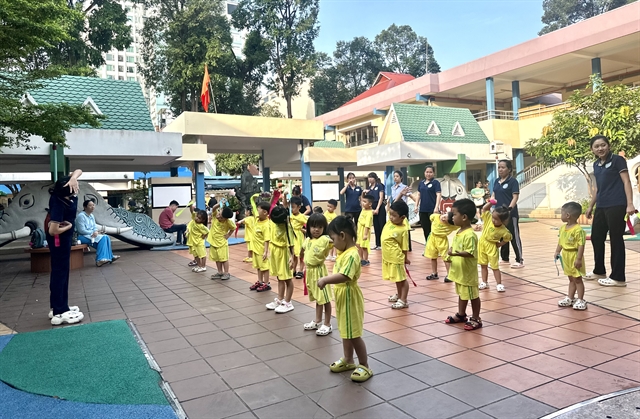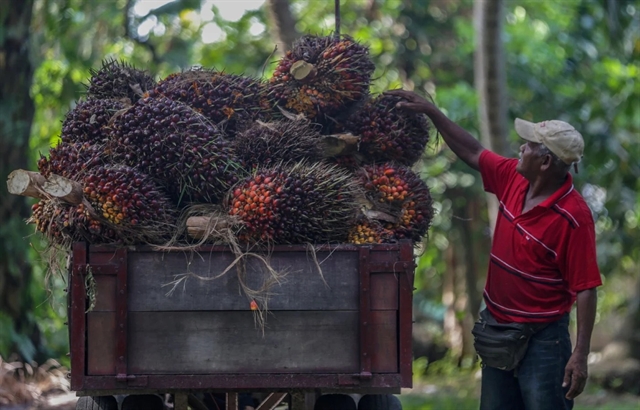 Society
Society

 |
| Kids do morning exercise at the HCM City Kindergarten in District 3. — VNS Photo Nguyễn Diệp |
HCM CITY — Along with its financial incentive policy for women bearing two children before 35 years old, HCM City is developing more long-term and sustainable policies to address its declining birth rate.
The city currently falls within the group of 21 provinces and cities experiencing low and consistently decreasing fertility rates from 1.39 children per woman in 2022 to 1.32 in 2023, a figure significantly below the replacement rate of 2.1.
This protracted period of sub-replacement fertility carries substantial long-term negative consequences, including accelerated population aging, labour shortages, and adverse impacts on social security systems.
Associate Professor Dr. Nguyễn Đức Lộc, director of the Institute for Social Life Research, said mitigating this trend requires HCM City to formulate adaptable population and labour policies geared toward enhancing citizens’ quality of life.
“The city must prioritise investment in healthcare, education, financial assistance for childcare, and the provision of social housing and accommodation for workers,” he said.
Tackling the low birth rate necessitates a concerted effort from the entire political apparatus, coupled with public consensus and support, Phạm Chánh Trung, head of the city's Division of Population and Family Planning, said.
Policy coherence across social security, educational support, healthcare provision, living standards, social housing, and personal income tax is essential to reassure couples contemplating parenthood and encourage them to have two children.
In late 2024, the municipal People’s Council ratified a resolution to incentivise and support collectives and individuals demonstrating exemplary performance in population management within the city.
The policy’s core provision is a VNĐ3 million grant (US$118) for women giving birth to two children before their 35th birthday, alongside a VNĐ2 million subsidy ($79) for prenatal and neonatal screenings for pregnant women and newborns from impoverished, near-impoverished, socially vulnerable, and island-dwelling households.
The city’s Department of Health is currently finalising a draft proposal outlining key interventions aimed at increasing the total fertility rate and enhancing the health of individuals in early life, children, and adolescents within the city until 2025 and beyond.
Upon approval, a suite of systemic policies and measures will be implemented to address the city’s declining birth rate.
 |
| Kindergarten students participate in an outdoor activity at a farm in HCM City’s Bình Chánh District. — VNS Photo Nguyễn Diệp |
Phan Văn Mãi, chairman of the municipal People’s Committee, said the low birth rate constitutes a significant challenge with far-reaching implications for the city’s socio-economic structure and operations.
The city has been concentrating on multi-faceted solutions to address this issue, aiming to adjust the total fertility rate to 1.4 children per woman by 2025, with a target of 1.6 by 2030.
The municipal People’s Committee issued Directive 17 on bolstering population management in the city’s new context.
This directive encompasses the development and enhancement of a comprehensive population service delivery network, focusing on the scale, structure, quality, and distribution of the population, with particular emphasis on elderly care, adaptation to population aging, and improvements in population health.
The municipal People’s Committee has also tasked the Department of Health with collaborating with the Department of Justice and relevant agencies to review and propose population-related policies to competent authorities, prioritising solutions to address the low birth rate and enhance population health within the city.
In addition to housing policies encompassing social housing projects and rental schemes for workers, the city is formulating sustainable policies pertaining to education, healthcare, and improvements in citizens’ quality of life.
The city is researching comprehensive education policies, including tuition waivers and reductions for students from preschool to high school, alongside other forms of support.
It is also developing a comprehensive, progressive healthcare programme.
It is also preparing to introduce regulations concerning health, psychological well-being, and legal literacy as prerequisites for marriage registration, once appropriate conditions are met.
Beyond these initiatives, the city is also prioritising elderly care, improvements to the working environment, enhancement of the quality of life, attraction of skilled labour, and increases in labour productivity, alongside the mobilisation of social resources to ensure social security, thereby implementing a comprehensive strategy to adapt to population aging.
The city's government and the health sector have introduced numerous advocacy, support, and incentive measures to encourage couples to have two children.
These aim to firmly maintain a replacement-level fertility rate, ensure a stable population growth rate, and keep a balanced working-age population.
They include abolishing the disincentives related to having a third child or more and encouraging women to marry before 30 and have two children before 35.
The Ministry of Health has also proposed cancelling disciplinary measures for Party members having a third child.
Furthermore, localities are researching, piloting, and expanding services such as child transportation, childcare facilities, milk banks, and family doctor programmes, alongside the strategic planning and construction of suitable childcare centres and kindergartens. — VNS




